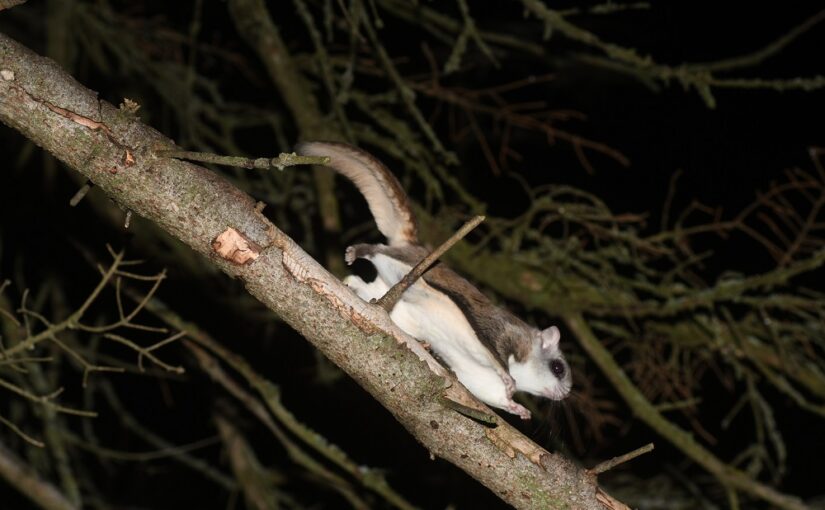Today’s post comes from Discovery Interpreter Mitchell Duval at Lake Superior Provincial Park.
When the sun goes down and most people are going to sleep, some of the most wonderous animals are waking up – including flying squirrels!
You may have heard of these fantastical creatures of the night, but how much do you really know about them?
Read on and find out why they might just be Ontario’s most unusual and interesting rodent.
Wait, I thought bats were the only flying mammals?
You caught me. While they aren’t capable of true flight, boy, can flying squirrels glide (and no short distance either)!
These tiny rodents can glide up to 45 m between trees, which is about 150 times their own body length. That’s the equivalent of the average human gliding four hockey rinks (if only we could)!

Flying squirrels accomplish this incredible feat using their “patagia,” wingsuit-like flaps of skin that connect from their wrists and forearms all the way to their ankles.
The squirrel will leap off a tree with their powerful hind legs and stretch out their limbs, spreading out those glorious patagia and gliding to their next destination.

Not only can they glide long distances, they can also maneuver like a fighter jet, making tight turns mid-air! They can thank their sixth “digit” for that nifty trick!
Although not a true digit, their wrist spur functions similarly to having another finger. It’s able to flex and act like the wingtip of a plane, reducing drag and making their “flights” more stable.
These arboreal acrobatics are an asset when attempting to avoid becoming a midnight snack for predators prowling in the darkness.
Superior squirrels
Believe it or not, while they are rarely seen due to their nocturnal habits and preference for dense forests, Ontario boasts not one, but two species of flying squirrel!
Populations of the two species overlap somewhat, though the Southern Flying Squirrel (Glaucomys volans) is primarily found in deciduous or mixed wood forests, while the Northern Flying Squirrel (Glaucomys sabrinus) is generally associated with conifer communities and boreal forests.

The rolling hills of the lush and biodiverse forests of Lake Superior Provincial Park are home to the Northern Flying Squirrel.
Here these squirrels are delighted to find a fully stocked kitchen, where nutritious mushrooms are plentiful and complemented by the various berries, seeds, and insects that round out their diet.
During the cold months, when other food sources become scarce, their diet shifts primarily to lichen which is especially abundant due to the humid climate created by Lake Superior.

The park’s forests also provide plenty of nesting opportunities in the form of cavities in mature hardwood trees or conifer tree branches where they build their dreys, structures similar to a bird’s nest.
Small but mighty
Canadian winters are no joke, especially at Lake Superior where lake-effect snow can accumulate to depths of two metres and the mean annual snowfall can exceed three metres!
Many animals either migrate or hibernate to escape these brutal winters, but flying squirrels prefer to tough it out.

Due to its larger body size, which allows it to better conserve heat, the Northern Flying Squirrel is especially well-equipped for the cold, compared to its southern cousin.
Flying squirrels will also (adorably) snuggle together in their nests to stay warm during the coldest stretches of winter.
Unlike other Ontario squirrels who store food to eat throughout winter, these resourceful rodents forage throughout the snowy season. They even tunnel through the dense blanket of snow to search for food on the ground!
Ontario’s thriving night life
Dark Sky Preserves, like Lake Superior Provincial Park, are havens for nocturnal animals who rely on darkness to thrive, including flying squirrels. These animals are truly built for the dark!
The huge eyes of flying squirrels are extra sensitive to light, giving them superior night vision compared to diurnal squirrels. In addition to their wicked eyesight, their ears are incredibly powerful, which is quite important when you communicate through ultrasonic calls.

Their frequency of ultrasonic sound is above the average range of human hearing, which maxes out at around 20 kHz. Flying squirrels have been recorded producing ultrasonic calls in excess of 50 kHz!
Owls, which are a prominent predator of flying squirrels, can only hear frequencies up to 12 kHz. This means squirrels can communicate without owls being any the wiser.
They use these tools, along with their super sensitive nose and whiskers, to maintain awareness of their surroundings and avoid the predators that lurk in the night.

Lake Superior’s Dark Sky Preserve provides stellar views of shining stars and flashy fireflies, but they aren’t the only things that light up our night sky.
Scientists have only recently made an illuminating discovery: flying squirrels can glow too! The fur on their bellies is biofluorescent, giving off a pink glow when exposed to ultraviolet light.
Now the biggest question on everyone’s mind: why?
Does it help them camouflage from their predators, many of whom can see UV light? Are they dressing to impress potential mates?
Honestly there isn’t enough research yet to say for certain. What we can say is that these are some truly fantastical creatures, like something out of a storybook, that parks help protect.
Keep your eyes peeled for flying squirrels!
Next time you’re camping or out in the woods after dark, keep an eye out!
If you’re lucky, you might just catch a glimpse of one of our most unusual and mysterious creatures of the night.
